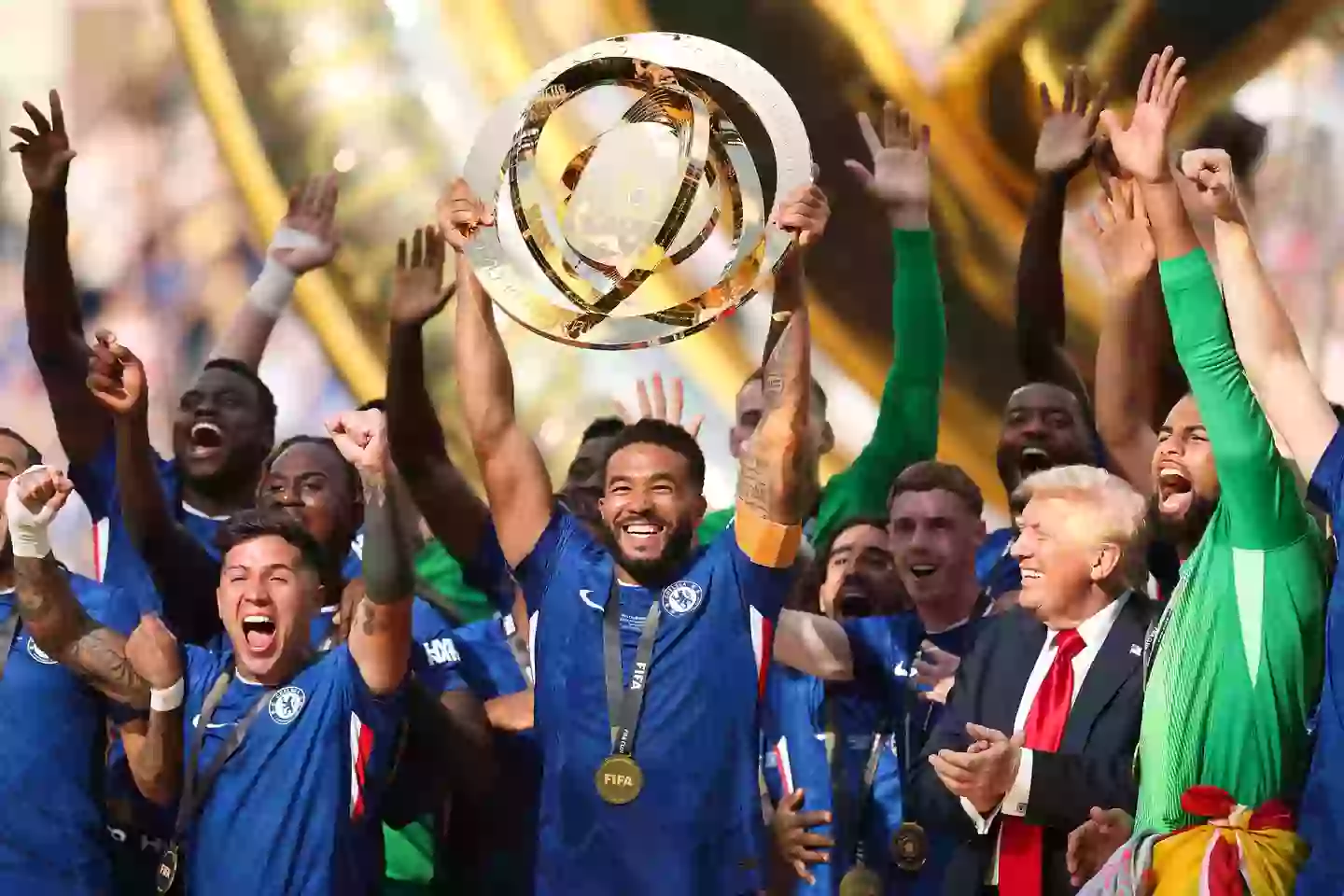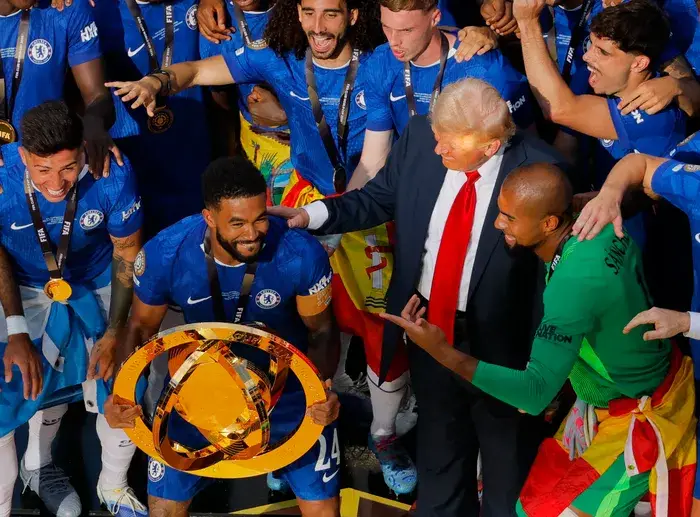Body Language Expert Analyzes Player Reactions to Trump’s Extended Participation in Chelsea’s FIFA Club World Cup Victory Celebration
Professional Non-Verbal Communication Analysis Reveals Player Confusion and Presidential Disconnect During Trophy Ceremony
The FIFA Club World Cup final at New Jersey’s MetLife Stadium concluded with Chelsea FC’s commanding 3-0 victory over Paris Saint-Germain, but the post-match celebration has generated extensive discussion due to President Donald Trump’s prolonged participation in the trophy presentation ceremony. Body language expert Darren Stanton has provided comprehensive analysis of the non-verbal communications and reactions observed during the incident, offering professional insight into the dynamics between the President and the celebrating Chelsea squad.

Chelsea’s Dominant Performance Sets Championship Stage
Chelsea FC delivered an exceptional performance against Paris Saint-Germain in what proved to be a one-sided affair at the prestigious FIFA Club World Cup final. The English club established their dominance early in the match, with talisman Cole Palmer contributing a decisive double that helped propel the team to a commanding 3-0 first-half lead.
The scoring was further enhanced by a goal from new signing João Pedro, demonstrating the squad’s depth and tactical versatility under pressure. The second half saw Paris Saint-Germain’s challenges compound when João Neves received a straight red card, effectively ending any hopes of a comeback for the French side.
This comprehensive victory represented a significant achievement for Chelsea FC, adding another prestigious international trophy to their collection and validating their status among the world’s elite football clubs. The triumph was particularly meaningful for captain Reece James and the squad’s leadership group, who had worked extensively to reach this pinnacle of club football.
The Trophy Presentation Protocol
Following the conclusion of the match, the traditional trophy presentation ceremony commenced with both President Trump and FIFA President Gianni Infantino approaching the Chelsea squad to formally present the championship trophy. This ceremony typically follows established protocol where presenting dignitaries hand over the trophy to the winning captain before stepping aside to allow the team their moment of private celebration.
The ceremony began according to standard procedure, with President Trump presenting the trophy to Chelsea captain Reece James in the presence of FIFA President Infantino. However, the situation deviated from typical protocol when FIFA President Infantino withdrew from the celebration area while President Trump remained standing alongside the team during their jubilant trophy-lifting moment.
This departure from conventional ceremony protocol created an unprecedented situation where a presenting dignitary continued to participate in what is traditionally considered the team’s private celebratory moment. The extended participation generated immediate attention from both the live audience and global television viewers, leading to widespread discussion about appropriate boundaries during sporting celebrations.
Professional Body Language Analysis of Player Reactions
Darren Stanton, a certified body language expert speaking on behalf of OLBG, conducted detailed analysis of the non-verbal communications displayed by Chelsea players during President Trump’s extended participation in their celebration. His professional assessment provides valuable insight into the players’ genuine reactions to the unexpected protocol situation.
According to Stanton’s analysis, Chelsea captain Reece James appeared relatively unaffected by President Trump’s presence during the initial moments of the celebration. “Reece James, who’s got the trophy initially, I don’t think he’s too fazed by Donald Trump. I think he’s just like in the moment, he’s ecstatic about the win, holding the trophy up,” Stanton observed.
The expert noted that James’s body language suggested he was primarily focused on the significance of the victory and the trophy itself, rather than being distracted by the unusual ceremonial circumstances. This reaction demonstrates the captain’s ability to maintain focus on the achievement while diplomatically managing an unexpected protocol situation.
Cole Palmer’s Visible Confusion
Stanton’s analysis revealed that Cole Palmer, Chelsea’s match-winning talisman, displayed the most obvious signs of confusion and bewilderment regarding President Trump’s continued presence during the celebration. The body language expert provided detailed interpretation of Palmer’s non-verbal communications during the incident.
“Cole Palmer, who is standing behind Trump, it’s quite a tight shot, and he’s like ‘What’s he doing here? Like what’s he got to do with it?'” Stanton explained. The expert’s analysis suggests that Palmer’s positioning and facial expressions clearly indicated his perplexity about the situation.
Stanton further elaborated on Palmer’s reaction, stating, “Palmer looks a bit perplexed as to why Trump is there. He’s got a sort of look of confusion and bewilderment on his face.” This professional assessment aligns with Palmer’s subsequent public comments about his confusion during the ceremony, providing corroborating evidence for the body language interpretation.
The analysis of Palmer’s reactions is particularly significant given his central role in Chelsea’s victory, having scored twice during the match. His visible confusion suggests that even the team’s star performer was uncertain about how to navigate the unexpected ceremonial circumstances.
Analysis of Presidential Body Language
Stanton’s professional assessment extended beyond the players’ reactions to include detailed analysis of President Trump’s own body language and non-verbal communication during the celebration. The expert’s observations suggest a disconnect between the President’s intended participation and his authentic comfort level within the sporting context.
“I think Trump is so disingenuous, he’s got such a fake smile, a masking smile, it’s almost like a dad at a wedding, he’s trying to show excitement, but he’s like a fish out of water,” Stanton assessed. This professional observation suggests that while President Trump attempted to demonstrate enthusiasm and engagement, his body language indicated discomfort or unfamiliarity with the sporting celebration environment.
The body language expert noted specific physical gestures that supported his assessment of inauthenticity. “Trump makes these kinds of fist gestures and jumps up and down. I just think Trump is trying his best to get involved in the excitement, but not really authentic,” Stanton explained.
This analysis provides insight into the challenges faced by political figures when attempting to participate naturally in sporting celebrations, highlighting the difference between practiced political engagement and spontaneous athletic jubilation.
Post-Match Player Testimonials
The body language analysis gained additional credibility through post-match interviews with Chelsea players, particularly Cole Palmer’s candid assessment of his experience during the trophy presentation. Palmer’s public comments provided direct confirmation of the confusion observed through professional body language interpretation.
“I knew he was going to be there, but I didn’t know he was going to be on the stand where we lift the trophy. So, I was a bit confused,” Palmer told the press following the match. This honest admission validates the body language expert’s assessment and provides insight into the lack of clear communication regarding protocol expectations.
Palmer’s statement highlights the importance of comprehensive briefings for all participants in high-profile ceremonial events, particularly when political figures are involved in sporting celebrations. The player’s confusion suggests that clearer advance communication about roles and expectations could have prevented the awkward situation.
Broader Implications for Sports and Politics Intersection
The incident and subsequent body language analysis raise important questions about the appropriate intersection between political figures and sporting celebrations. The professional assessment reveals the complexity of managing such situations when traditional protocol boundaries become unclear.
The analysis demonstrates how non-verbal communication can provide valuable insight into genuine reactions versus diplomatic politeness during public events. The contrast between the players’ attempts to maintain celebratory momentum and their visible confusion illustrates the challenges of navigating unexpected protocol situations in real-time.
Professional Insights on Authenticity in Public Settings
Stanton’s analysis provides broader insights into authenticity during public appearances, particularly in contexts where individuals may be outside their comfort zones. The expert’s assessment of President Trump’s body language offers a case study in how genuine enthusiasm differs from performed engagement.
The comparison to “a dad at a wedding” provides relatable context for understanding the disconnect between attempted participation and natural comfort within specific social settings. This professional observation highlights how body language experts can identify subtle indicators of genuine versus manufactured emotional responses.
Protocol Considerations for Future Events
The incident and its subsequent analysis suggest the need for more detailed protocol planning when high-profile political figures participate in sporting celebrations. Clear guidelines regarding the duration and extent of dignitary participation could help prevent similar situations while maintaining appropriate diplomatic courtesy.
Event organizers may benefit from establishing specific timelines and expectations for all participants, including distinguished guests, to ensure that sporting achievements receive appropriate focus while maintaining diplomatic relationships.
Conclusion
The FIFA Club World Cup final trophy presentation incident provides a fascinating case study in non-verbal communication analysis and protocol management during high-profile sporting events. Darren Stanton’s professional body language assessment offers valuable insights into the genuine reactions of both the celebrating Chelsea players and President Trump during an unprecedented ceremonial situation.
The analysis reveals the complexity of managing intersections between sports and politics, highlighting how professional expertise in non-verbal communication can provide deeper understanding of public interactions. The incident underscores the importance of clear protocol communication and the challenges faced by all participants when traditional ceremonial boundaries become unclear.
Moving forward, this analysis may inform improved protocol planning for similar events, ensuring that both sporting achievements and diplomatic courtesy receive appropriate attention while minimizing confusion for all participants involved.

Ethan Blake is a skilled Creative Content Specialist with a talent for crafting engaging and thought-provoking narratives. With a strong background in storytelling and digital content creation, Ethan brings a unique perspective to his role at TheArchivists, where he curates and produces captivating content for a global audience.
Ethan holds a degree in Communications from Zurich University, where he developed his expertise in storytelling, media strategy, and audience engagement. Known for his ability to blend creativity with analytical precision, he excels at creating content that not only entertains but also connects deeply with readers.
At TheArchivists, Ethan specializes in uncovering compelling stories that reflect a wide range of human experiences. His work is celebrated for its authenticity, creativity, and ability to spark meaningful conversations, earning him recognition among peers and readers alike.
Passionate about the art of storytelling, Ethan enjoys exploring themes of culture, history, and personal growth, aiming to inspire and inform with every piece he creates. Dedicated to making a lasting impact, Ethan continues to push boundaries in the ever-evolving world of digital content.
